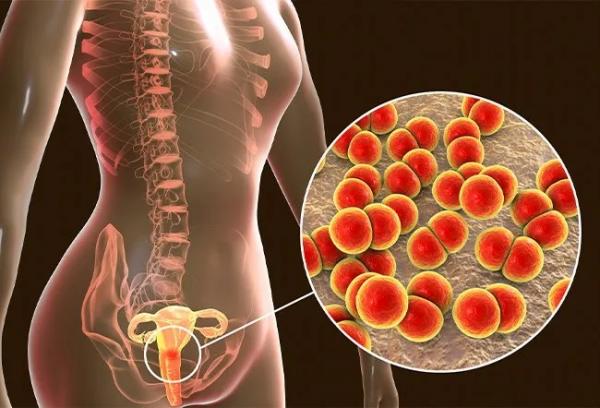Chlamydia, ways of transmission, symptoms and treatment

 chlamydia
chlamydiaWhat is chlamydia?
According to the American CDC, chlamydia is one of the types of sexually transmitted diseases that can affect sexually active men and women. This disease is caused by a bacterium called Chlamydia trachomatis. One of the complications of this disease is damage to the reproductive system of women. Some of the complications caused will be permanent so that in some women they cause infertility or pregnancy disorders, also another complication of chlamydia infection for women is increasing the possibility of ectopic pregnancy.
People at risk of chlamydia:
Anyone who is sexually active can get a chlamydia infection, especially if the relationship is unprotected, however, a group of people are at greater risk for biological or behavioral reasons.
Adolescents in the age group of 15-24 are more at risk and account for almost two-thirds of all cases.
The anatomy of women's body has caused the possibility of STD infections to increase in women. The delicate and thin skin around the vagina compared to the skin of the male penis will lead to better penetration of bacteria. Approximately 1 out of every 20 sexually active young women between the ages of 14 and 24 is infected with chlamydia.
On the other hand, men who have same-sex relationships are more at risk and can contract chlamydia through oral or anal sex.
 People at risk of chlamydia
People at risk of chlamydiaThe way chlamydia is transmitted:
This infection is often transmitted through sexual contact with a person with chlamydia. Even if ejaculation does not occur during intercourse, transmission occurs. The main way people get chlamydia is vaginal sex and anal sex, however, the disease can also be transmitted through oral sex.
Chlamydia is rarely transmitted by touching the eyes with hands contaminated with fluids containing chlamydia bacteria. If a pregnant woman has chlamydia, there is a possibility that the baby will get the disease during birth.
Chlamydia is not transmitted by normal contact, so you should not worry about using oral food or drink, kissing, hugging, shaking hands, coughing, sneezing, sitting on the toilet, etc.
The best way to prevent chlamydia is to use a condom or mouthguard every time you have sex.
Types of chlamydia:
Vaginal chlamydia infection (chlamydia in women):
If a woman has unprotected sex with an infected sexual partner, the chance of getting chlamydia infection is very high. Chlamydia is a bacterial infection that can affect the cervix, uterus or vagina, although the infection is dangerous and includes various symptoms. One of the symptoms that may occur in the vagina is abnormal discharge. Of course, it should be noted that chlamydia is not the only cause of vaginal infection, but this infection can have various reasons.
Chlamydia is a type of bacterial infection that will cause more severe complications and symptoms in women. This infection can affect the mouth and throat if you have oral sex with an infected person.
Chlamydia in men:
There is a possibility that men will be infected with chlamydia, although the symptoms will not be as severe as women's and may only cause limited complications. It should be noted that infected men can make women sick.
Chlamydia in the throat:
People who have oral sex can get chlamydia in the throat area. Of course, chlamydia often forms a disease in the penis, but if a person has unprotected oral sex, the probability of the bacteria sitting in the throat will increase.
 Chlamydia in the throat
Chlamydia in the throatChlamydia symptoms:
Symptoms of chlamydia in men:
Most people with chlamydia have no symptoms, or if they do, they develop weeks after unprotected sex. Even if a person is infected with chlamydia and has no symptoms and continues without treatment, it can damage the reproductive system and eventually lead to epididymitis or infertility. For this reason, if you have sex without a condom, testing for sexually transmitted diseases is very important.
Symptoms of chlamydia in men can include the following:
– Discharge of pus or watery or milky liquid from the male penis
– Pain or burning when urinating
– Pain or swelling in one or both testicles
– On the other hand, chlamydia can appear in the subordinate part, which often follows anal sex.
The following symptoms will not be common but may be seen in this infection:
– Pain or itching in the anus (denominator)
– discharge of secretions or bleeding from the anus
– Diarrhea
– Swelling in or around the anus
Chlamydia can also infect your eyes and cause redness, itching, or discharge from them.
– Regardless of the location of chlamydia symptoms in the body, the probability of these symptoms occurring in men is higher in the morning.
If you encounter any of the symptoms, if it is determined that your partner is suffering from chlamydia, and if your sexual partner shows any symptoms, you should immediately contact a specialist doctor to get treatment as soon as possible.
Chlamydia symptoms in women:
Most of the people who get chlamydia do not have symptoms or if they have it, it appears long after unprotected sexual contact. If you do not have symptoms and do not receive treatment, there is a possibility of damage to the reproductive system and eventually it can cause the disease. Pelvic inflammatory diseases or infertility. For this reason, it is recommended in case of unprotected sex; Perform surveillance disease tests.
Symptoms of chlamydia in women can include the following:
– Abnormal vaginal secretions, yellow and with a strong smell
– Swelling inside the vagina / painful intercourse
– Pain or burning when urinating
– Excitement more than usual to urinate
– If the infection spreads beyond the vagina and cervix, the patient may experience the following symptoms:
– Pain in the abdomen or back
– Nausea or low grade fever
– Bleeding between periods itself or Bleeding after sex vaginal
– On the other hand, chlamydia can appear in the subordinate part, which often follows anal sex.
The following symptoms will not be common but may be seen in this infection:
– Pain or itching in the anus (denominator)
– discharge of secretions or bleeding from the anus
– Diarrhea
– Swelling in or around the anus
Chlamydia can also infect your eyes and cause redness, itching, or discharge from them.
 Symptoms of chlamydia in women
Symptoms of chlamydia in womenChlamydia treatment:
The best treatment currently considered for chlamydia is antibiotics. In this case, the treatment may be gradual or done with a single dose. There is a possibility that the doctor will prescribe a large dose of antibiotics. In another method, the doctor may recommend that the patient take antibiotics one or more times for 5 to 10 days.
Often this disease will be treated with drug treatment with a process of 7 to 14 days. During this time, the patient should refrain from sexual intercourse.
Another important point that needs attention is that the sexual partner of the patient should also be examined and treated for chlamydia. Since this disease is sexually transmitted and can spread, it is very important to pay attention to the sexual partner of the disease, otherwise the disease will return. If the drug treatment of one strain is carried out, the risk of transmission and recurrence of the disease will increase.
Vaginal chlamydia infection will often be treated and controlled after a course of treatment with antibiotics. More than 95% of people with vaginal chlamydia infection can achieve the desired goal after following the correct treatment process. Antibiotic treatment is usually started after the infection is confirmed by testing.
 Drug treatment of chlamydia
Drug treatment of chlamydiaAntibiotics to treat chlamydia:
In general, antibiotics are used to treat chlamydia patients, and in most cases, the problem will be solved. The doctor usually uses antibiotics after checking the test results and confirming that the person has chlamydia infection, on the other hand, if the patient has clear signs of infection, there is a possibility of treatment before the test.
Treatment with azithromycin is one of the most effective treatment methods for chlamydia. In this method, the doctor uses doses of 1 gram and a dose of 500 mg, and the treatment is carried out during 2 days. On the first day, the patient receives a dose of 1 gram of the drug, and on the next day, a dose of 500 mg is used.
Doxycycline is another commonly used antibiotic in the treatment of chlamydia. This treatment usually does not last more than 7 days. During 1 week, the patient must take a certain amount of doxycycline prescribed by the doctor every day.
Another effective drug for chlamydia treatment is ciprofloxacin. Treatment with this drug usually lasts 3 days, and during these 3 days, the patient must take ciprofloxacin 500 mg twice a day. This drug treatment is also safe in pregnant women with this infection.
It should be noted that the mentioned contents cannot replace the doctor's opinion and you should consult a doctor before taking any action.
The use of metronidazole for the treatment of chlamydia is not well approved. In general, metronidazole does not have the ability to treat this infection and is not recommended to control the disease, but sometimes it is seen that this drug is used to treat chlamydia. For example, if symptoms of infection are still observed after completing the course of treatment with doxycycline, levofloxacin and azithromycin, metronidazole can be prescribed.
In some cases, this drug is used to treat possible bacterial infections that have symptoms similar to chlamydia. Bacterial vaginosis, moderate pelvic inflammatory disease and trichomoniasis are among the complications that are controlled and treated with metronidazole.
Home treatment for chlamydia:
It cannot be said for sure that home remedies can cure chlamydia, but some methods may be able to improve the symptoms of chlamydia or prevent its progressive process. Among the home methods that are suggested to fight chlamydia include the following:
probiotic:
There is a high volume of healthy and beneficial bacteria in goat yogurt, kombucha and coconut kefir. The probiotics in these foods will help a person fight chlamydia and other bad bacteria more easily.
Oregano oil:
Oregano extract contains a large amount of thymol and carvacrol, which are very useful for fighting chlamydia.
Garlic:
One of the best foods to fight infection is garlic. This food contains a chemical called allicin, which has antiviral, antifungal and antimicrobial properties. People with chlamydia infection can increase immunity and fight chlamydia symptoms by including garlic in their meals.
 Home treatment of chlamydia using garlic
Home treatment of chlamydia using garlicgold seal flower:
One of the useful plants for the treatment of ocular chlamydia is Gold Mehr Gold. In fact, this plant has berberine that can treat and control eye chlamydia. Berberine has an alkaline property and has a beneficial effect with its antibacterial and antiviral properties. According to the studies, people suffering from eye chlamydia after consuming eye drops containing berberine do not experience the return of the disease even one year after the treatment.
compilation: Covered sexual health department






